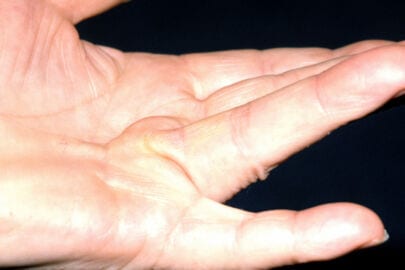Introduction
A mucous cyst is a fluid-filled mass that may develop in the fingers or the thumb. These cysts typically appear in patients 50 years of age and older. A mucous cyst is a benign mass, and does not represent a cancer or tumor. Despite their benign nature, the cysts can be painful and can cause cosmetic concerns for patients. There are successful treatments to eradicate the cysts when needed. This guide will provide useful information to patients regarding these cysts and their treatment.
Anatomy and Background
Like many other cysts, mucous cysts arise from a joint. Mucous cysts usually affect the terminal joints of the hand, or the distal interphalangeal (DIP) joint of the fingers and the interphalangeal (IP) joint of the thumb. As we age, our joints develop degenerative changes that can result in excess production of joint fluid. Finger range of motion pressurizes the joint and can force excess joint fluid to balloon outwards through the joint capsule. The cyst remains connected to the joint via a tiny stalk. This stalk acts as a one way valve, preventing return of the fluid into the joint.

Symptoms of a Digital Mucous Cyst
Mucous cysts concern patients for several reasons. First the mass may be painful, especially when bumped. More often, however, patients have cosmetic concerns. The cysts can resemble warts and are on full display on top of the fingers. Occasionally they grow to very large sizes. In many cases the mass may grow towards the end of the finger where it can put pressure on the nail bed. Over time, pressure on the nail bed can cause a longitudinal indentation in the finger nail to develop. They can thin the overlying skin, causing it to rupture. When a mass has ruptured, the patient is at risk for developing an infection that can spread to the joint and cause significant damage.

Do you have a Digital Mucous Cyst?
A mucous cyst is best diagnosed by physical examination. The mass has a characteristic appearance—a round, raised mass usually 3-5 millimeters in diameter, often bubble-like in its appearance. The location—on the top side of the DIP joint, to either side of the extensor tendon—is also characteristic. If the mass is longstanding and has compressed the nail bed, a longitudinal groove in the finger nail distal to the mass may be appreciated.
X-rays may be obtained to evaluate the finger, but are not typically needed for diagnosis. Frequently, signs of osteoarthritis, such as bone spurs and narrowing of the joint, can be seen on X-ray.
Treatment
Because mucous cysts are benign, they do not require treatment. If a patient desires, they can simply ignore, or neglect, the cyst. Evidence suggests that some cysts may resolve on their own over time.
Treatment is considered for any patients who feel their cysts are painful, cause cosmetic concerns, or are otherwise bothersome. One option is aspiration of the cyst with or without a steroid injection. This procedure involves draining the cyst with a needle in a sterile fashion. It can be performed in the clinic setting and does not require a trip to the operating room. However, the cyst will come back in 50% or more of cases.
Surgery provides the best option remove mucous cysts and prevent recurrence. Surgery is typically performed in the outpatient setting under light sedation and local anesthesia. An incision over the joint allows exposure of the cyst. The cyst is traced down to the joint, where its stalk and the surrounding capsule are removed. Bone spurs are removed from the joint. The wound is closed with sutures and a dressing and splint applied. After surgery, a sutures are removed in about 10 days and range of motion is resumed. Recovery is straightforward, and therapy is not necessary.
It is worth noting that the recurrence rate with surgery is approximately 5%. Patients with significant arthritis in the DIP joint should be aware that removal of the cyst may not address pain at the joint. Patients with significant pain from arthritis and a mucous cyst may best be treated with fusion of the joint, which will eliminate the cyst and the pain from arthritis.
Do you feel you have a Digital Mucous Cyst? Let’s get you treated. Request your appointment here.




